Kenwood TK-885, TK-785 Operation Manual [es]

INSTRUCTION MANUAL
VHF FM TRANSCEIVER/ UHF FM TRANSCEIVER
TK-785/ TK-885
KENWOOD CORPORATION
© B62-1434-00 (E)
09 08 07 06 05 04 03 02 01 00

Thank You
We are grateful you chose KENWOOD for your personal mobile applications. We believe this easy-to-use transceiver will provide dependable communications to keep personnel operating at peak efficiency.
KENWOOD transceivers incorporate the latest in advanced technology. As a result, we feel strongly that you will be pleased with the quality and features of this product.
Models Covered by this Manual
•TK-785: VHF FM Transceiver
•TK-885: UHF FM Transceiver
Precautions
Please observe the following precautions to prevent fire, personal injury, and transceiver damage.
•Do not attempt to configure the transceiver while driving; it is too dangerous.
•Do not modify the transceiver for any reason.
•Do not expose the transceiver to long periods of direct sunlight, nor place it near heating appliances.
•Do not place the transceiver in excessively dusty, humid, or wet areas, nor on unstable surfaces.
•If an abnormal odour or smoke is detected coming from the transceiver, remove the power input connector from the DC power cable. Contact your KENWOOD dealer.
•Continuously transmitting for more than 1 minute causes the transceiver to get hot; to preven overheating, do not continuously transmit for over 1 minute.
Notices to the User
GOVERNMENT LAW PROHIBITS THE OPERATION OF UNLICENSED RADIO TRANSMITTERS WITHIN THE TERRITORIES UNDER GOVERNMENT CONTROL.
ILLEGAL OPERATION IS PUNISHABLE BY FINE AND/OR IMPRISONMENT.
REFER SERVICE TO QUALIFIED TECHNICIANS ONLY.
SAFETY: It is important that the operator is aware of, and understands, hazards common to the operation of any transceiver.
WARNING!
EXPLOSIVE ATMOSPHERES (GASES, DUST, FUMES, etc.)
Turn OFF your transceiver while taking on fuel or while parked in a gasoline service station. Do not carry spare fuel containers in the trunk of your vehicle if your transceiver is mounted in the trunk area.
INJURY FROM RADIO FREQUENCY TRANSMISSIONS
Do not operate your transceiver when somebody is either touching the antenna or standing within two to three feet of it, to avoid the possibility of radio frequency burns or related physical injury.
DYNAMITE BLASTING CAPS
Operating the transceiver within 500 feet (150 meters) of dynamite blasting caps may cause them to explode. Turn OFF your transceiver when in an area where blasting is in progress, or where
“TURN OFF TWO-WAY RADIO” signs have been posted. If you are transporting blasting caps in your vehicle, make sure they are carried in a closed metal box with a padded interior. Do not transmit while the caps are being placed into or removed from the container.
i

CONTENTS |
|
UNPACKING AND CHECKING EQUIPMENT ............................................... |
1 |
Supplied Accessories .............................................................................. |
1 |
PREPARATION ............................................................................................... |
2 |
Tools Required ......................................................................................... |
2 |
Power Cable Connection ........................................................................ |
2 |
Installing the Transceiver........................................................................ |
3 |
THE BASICS ................................................................................................... |
4 |
Front Panel ............................................................................................... |
4 |
Rear Panel ................................................................................................. |
5 |
Switching the Transceiver ON/ OFF....................................................... |
5 |
Adjusting the Volume .............................................................................. |
5 |
TRUNKING MODE .......................................................................................... |
6 |
Key Functions .......................................................................................... |
6 |
Programmable Auxiliary Functions ....................................................... |
6 |
Display ...................................................................................................... |
7 |
Searching for a Control Channel ........................................................... |
7 |
Voice Calls ................................................................................................ |
8 |
Making a Voice Call ............................................................................ |
8 |
Receiving a Voice Call ....................................................................... |
9 |
Status Calls............................................................................................... |
9 |
Making a Status Call .......................................................................... |
9 |
Receiving a Status/Short Data Message Call................................ |
10 |
Call Displays ........................................................................................... |
10 |
Viewing the Stack .................................................................................. |
10 |
Call Diversions ....................................................................................... |
11 |
Diverting Your Own Calls ................................................................ |
11 |
Diverting Third Party Calls .............................................................. |
11 |
CONVENTIONAL MODE .............................................................................. |
12 |
Key Functions ........................................................................................ |
12 |
Display .................................................................................................... |
12 |
Entering Conventional Mode ................................................................ |
13 |
Returning to Trunking Mode ................................................................. |
13 |
Conventional Mode Operation ............................................................. |
13 |
Scanning ................................................................................................. |
14 |
APPENDIX..................................................................................................... |
15 |
ii
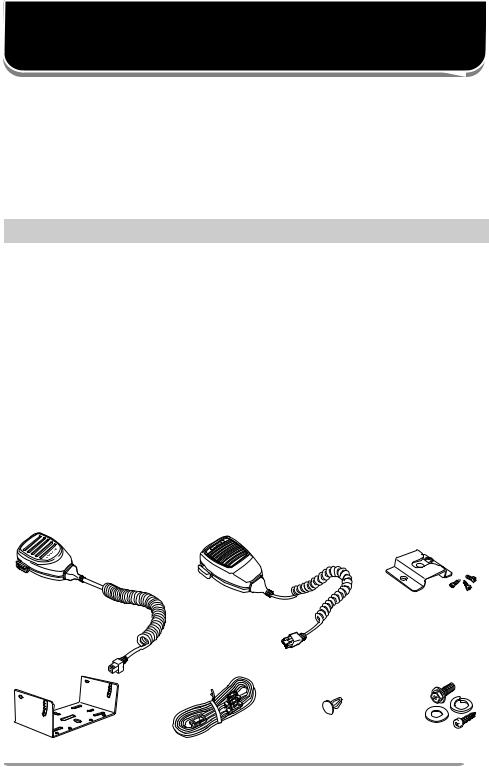
UNPACKING AND CHECKING EQUIPMENT
Note: The following unpacking instructions are for use by your KENWOOD dealer, an authorized KENWOOD service facility, or the factory.
Carefully unpack the transceiver. We recommend that you identify the items listed in the following table before discarding the packing material. If any items are missing or have been damaged during shipment, file a claim with the carrier immediately.
Supplied Accessories
Item |
|
Part Number |
Quantity |
|
|
|
|
|
|
Microphone and |
TK-785 E only |
T91-0624-XX |
1 |
|
microphone cable |
TK-885 K only |
T91-0621-XX |
||
|
||||
|
|
|
|
|
Microphone hanger with self-tapping screws |
J19-1584-XX |
1 |
||
(supplied only with kits containing a microphone) |
||||
|
|
|||
|
|
|
|
|
Mounting bracket |
|
J29-0627-XX |
1 |
|
|
|
|
|
|
Power cable assembly |
|
E30-3438-XX |
1 |
|
|
|
|
||
• 10 A Fuse (2 pieces) |
|
F52-0006-XX |
||
|
|
|||
|
|
|
|
|
Speaker jack cap |
|
B09-0235-XX |
1 |
|
|
|
|
|
|
Screw set: |
|
|
|
|
• Self-tapping screw (4 pieces) |
|
|
||
• Hex-headed screw with washer (4 pieces) |
N99-0395-XX |
1 |
||
• Spring washer (4 pieces) |
|
|
||
• Flat washer (4 pieces) |
|
|
|
|
|
|
|
|
|
Instruction manual |
|
B62-1434-XX |
1 |
|
|
|
|
|
|
Microphone |
Microphone |
Microphone |
(TK-785 E only) |
(TK-885 K only) |
hanger |
Mounting bracket |
Power cable assembly Speaker jack cap |
Screw set |
1
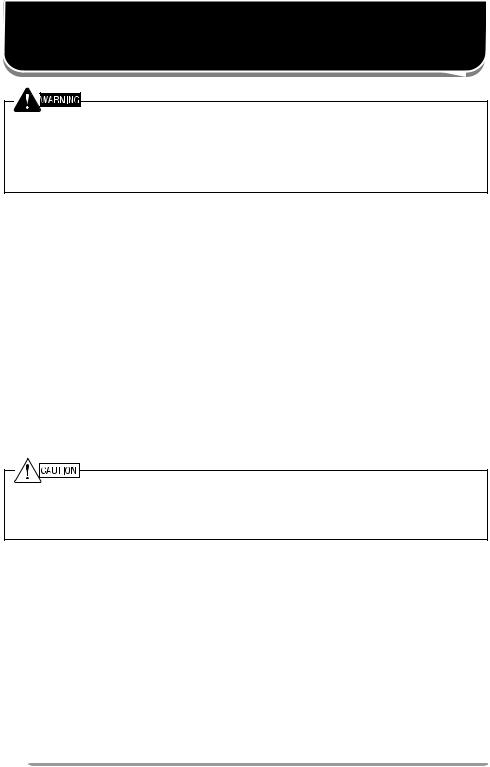
PREPARATION
VARIOUS ELECTRONIC EQUIPMENT IN YOUR VEHICLE MAY MALFUNCTION IF THEY ARE NOT PROPERLY PROTECTED FROM THE RADIO FREQUENCY ENERGY WHICH IS PRESENT WHILE TRANSMITTING. ELECTRONIC FUEL INJECTION, ANTI-SKID BRAKING, AND CRUISE CONTROL SYSTEMS ARE TYPICAL EXAMPLES OF EQUIPMENT THAT MAY MALFUNCTION. IF YOUR VEHICLE CONTAINS SUCH EQUIPMENT, CONSULT THE DEALER FOR THE MAKE OF VEHICLE AND ENLIST
HIS AID IN DETERMINING IF THEY WILL PERFORM NORMALLY WHILE TRANSMITTING.
Note: The following preparation instructions are for use by your KENWOOD dealer, an authorized
KENWOOD service facility, or the factory.
Tools Required
Note: Before installing the transceiver, always check how far the mounting screws will extend below the mounting surface. When drilling mounting holes, be careful not to damage vehicle wiring or parts.
The following tools are required for installing the transceiver:
•6 mm (1/4 inch) or larger electric drill.
•4.2 mm (5/32 inch) drill bit for the 5 x 16 mm self-tapping screws, and 3.2 mm (1/8 inch) drill bit for the 4 x 16 mm self-tapping screws.
•Circle cutters.
Power Cable Connection
THE TRANSCEIVER OPERATES IN 12 V NEGATIVE GROUND SYSTEMS ONLY! CHECK THE BATTERY POLARITY AND VOLTAGE OF THE VEHICLE BEFORE INSTALLING THE TRANSCEIVER.
LOCATE THE POWER INPUT CONNECTOR AS CLOSE TO THE TRANSCEIVER AS POSSIBLE.
1Check for an existing hole, conveniently located in the firewall, where the power cable can be passed through.
•If no hole exists, use a circle cutter to drill the firewall, then install a rubber grommet.
2Run the two power cable leads through the firewall and into the engine compartment, from the passenger compartment.
3Connect the red lead to the positive (+) battery terminal and the black lead to the negative (–) battery terminal.
•Locate the fuse as close to the battery as possible.
4Coil and secure the surplus cable with a retaining band.
•Be sure to leave enough slack in the cables so the transceiver can be removed for servicing while keeping the DC power applied.
2
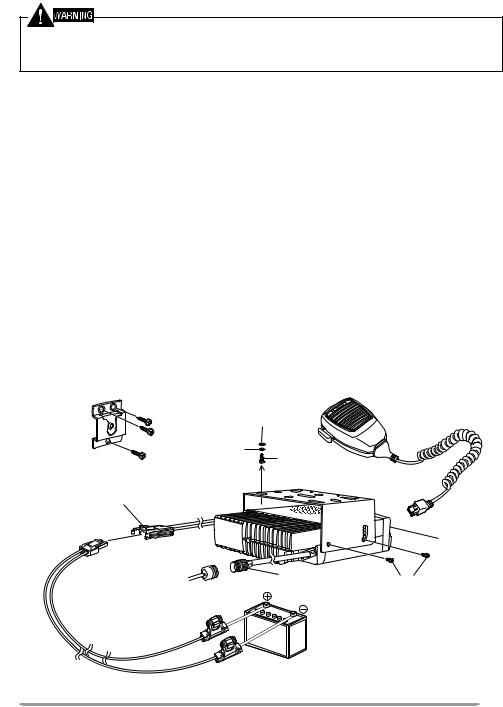
Installing the Transceiver
FOR PASSENGER SAFETY, INSTALL THE TRANSCEIVER SECURELY, USING THE SUPPLIED MOUNTING BRACKET, SO THE TRANSCEIVER WILL NOT BREAK LOOSE IN THE EVENT OF A COLLISION.
1Mark the position of the holes in the dash by using the mounting bracket as a template. Drill the holes, then attach the mounting bracket using the supplied 5 x 16 mm screws.
•Be sure to mount the transceiver in a location where the controls will be within easy reach of the user and where there is sufficient space at the rear of the transceiver for cable connections.
2Connect the antenna and the supplied power cable to the transceiver.
3Slide the transceiver into the mounting bracket and secure it using the supplied hex-headed screws.
4Mount the microphone hanger, using the supplied 4 x 16 mm screws, in a location where it will be within easy reach of the user.
•The microphone should be mounted in a place where it will not interfere with the safe operation of the vehicle.
5Connect the microphone cable to the jack on the front panel of the transceiver. Place the microphone on the hanger.
Microphone hanger
|
|
Microphone and |
Flat washer |
microphone cable |
|
|
||
Spring washer |
5 x 16 mm |
|
|
|
|
|
self-tapping screw |
|
Power input connector
|
Mounting |
|
bracket |
Antenna |
Hex-headed screw |
connector |
DC power cable |
Vehicle |
|
battery |
3
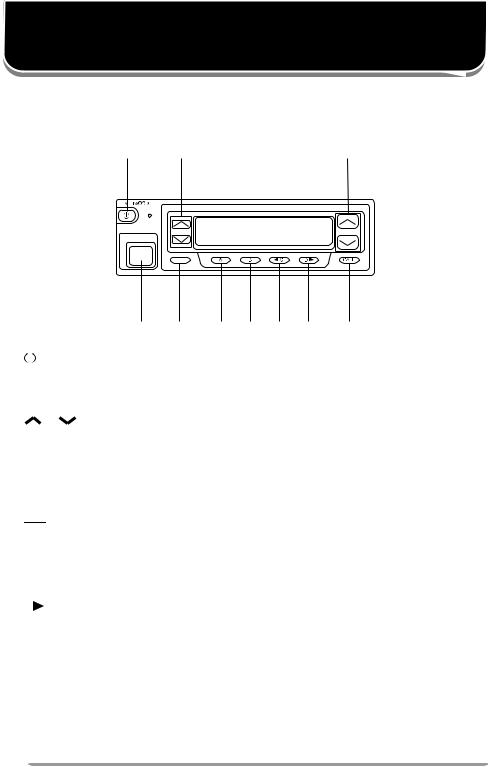
THE BASICS
Note: Features listed in this section are available for both Trunking and Conventional modes. Mode specific features can be found in their corresponding sections in this manual.
Front Panel
q w e |
r |
|||
|
|
|
|
|
|
|
|
|
|
|
|
|
t |
y |
u i o !0 |
!1 |
q |
|
(DC Source) switch |
|
|
|
|
|
|
|
|
|||
|
|
|
|
|||
|
Press to switch the transceiver ON (or OFF). |
|
||||
w Transmit/ Receive indicator |
|
|
||||
e |
/ |
(Volume) keys |
|
|
|
|
|
Press these keys to increase and decrease the volume. |
|||||
r  /
/  (Control) keys
(Control) keys
tMicrophone jack
Insert the microphone plug into this connector.
y  key
key
u A key i B key o  C key
C key
!0D key
!1CALL key
4

Rear Panel
|
|
|
|
|
|
|
|
|
|
|
|
|
|
|
|
|
|
|
|
|
|
|
|
|
|
|
|
|
|
|
|
|
|
|
|
|
|
|
|
|
|
|
|
|
|
|
|
|
|
|
|
|
|
|
|
|
|
|
|
|
|
|
|
|
|
|
|
|
|
|
|
|
|
|
|
|
|
|
|
|
|
|
|
|
|
|
|
|
|
|
|
|
|
|
|
|
|
|
|
|
|
|
|
|
|
|
|
|
|
|
|
|
|
|
|
|
|
|
|
|
|
|
|
|
|
|
|
|
|
|
|
|
|
|
|
|
|
|
|
|
|
|
|
|
|
|
|
|
|
|
|
|
|
|
|
|
|
|
|
|
|
|
|
|
|
|
|
|
|
|
|
|
|
|
|
|
|
|
|
|
|
|
|
|
|
|
|
|
|
|
|
|
|
|
|
|
|
|
|
|
|
|
|
|
|
|
|
|
|
|
|
|
|
|
|
|
|
|
|
|
|
|
|
|
|
|
|
|
|
|
|
|
|
|
|
|
|
|
|
|
|
|
|
|
|
|
|
|
|
|
|
|
|
|
|
|
|
|
|
|
|
|
|
|
|
|
|
|
|
|
|
|
|
|
|
|
|
|
|
Power input |
External |
|
|
|||||||||||||||||||||||||||||||
|
|
|||||||||||||||||||||||||||||||||
connector |
speaker jack |
|
|
|||||||||||||||||||||||||||||||
|
|
|||||||||||||||||||||||||||||||||
Antenna connector
Switching the Transceiver ON/ OFF
Press the  switch to switch the transceiver ON. The startup text or unit number appears for 2 seconds.
switch to switch the transceiver ON. The startup text or unit number appears for 2 seconds.
Press the  switch again to switch the transceiver OFF.
switch again to switch the transceiver OFF.
Adjusting the Volume
Press the  /
/  (volume) keys to adjust the volume.
(volume) keys to adjust the volume.  increases the volume and
increases the volume and  decreases it.
decreases it.
5

TRUNKING MODE
Key Functions
Note: The numbers correspond to the diagram on page 4.
w Transmit indicator
Lights red while transmitting.
r  /
/  (Control) keys
(Control) keys
Press these keys to select your desired call address (voice calls) or status (status calls).
y
 key
key
Press to end the current call.
u A key (default setting: Status/ Stack)
Press to activate its auxiliary function {below}.
i B key (default setting: Redial)
Press to activate its auxiliary function {below}.
oC key (default setting: None)
Press to activate its auxiliary function {below}. Also press to scroll left while viewing stack entries.
!0D key (default setting: None)
Press to activate its auxiliary function {below}. Also press to scroll right while viewing stack entries.
!1CALLkey
Press to call the displayed call address.
Programmable Auxiliary Functions
The A, B, C, and D keys, as well as the external foot switch, can be programmed with the auxiliary functions listed below. Contact your dealer for details on these functions.
Note: Some of these functions cannot be programmed onto certain keys. Ask your dealer for details.
• |
AUX A |
• |
Horn Alert |
• |
AUX B |
• |
Key Lock |
• |
Call |
• |
Network Select |
• |
Clear |
• |
None |
• |
Conventional |
• |
Public Address |
• |
Dialing |
• |
Redial |
• |
Emergency |
• |
Scrambler |
• |
Home |
• |
Status/ Stack |
6
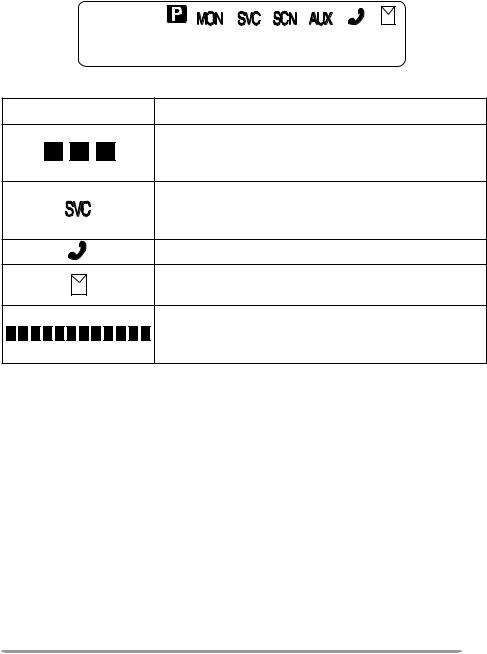
Display
Note: Messages can appear in either English or Spanish, depending on how your dealer sets up the transceiver. All messages described in this manual are listed in English.
|
|
|
|
|
|
|
|
|
|
|
|
|
|
|
|
|
|
|
|
|
|
|
|
|
|
|
|
|
|
|
|
|
|
|
|
|
|
|
|
|
|
|
|
|
|
|
|
|
|
|
|
|
|
|
|
|
|
|
|
|
|
|
|
|
|
|
|
|
|
|
|
|
|
|
|
|
|
|
|
|
|
|
|
|
|
|
|
|
|
|
|
|
|
|
|
|
|
|
|
Icon |
|
|
|
|
|
|
|
|
|
|
|
|
|
|
Description |
|||||||||
|
|
|
|
|
|
|
|
|
|
|
|
|
|
|
|
|
|
|
|
|
|
|
|
|
Displays the strength of received signals, the output power (high or low), status numbers, and received call types.
Appears when a control channel is found. Flashes while the transceiver is searching for a control channel.
Flashes when you activate call diversion.
Appears while there is data in the stack. Flashes when there is new data in the stack.
Displays call addresses, the call duration timer, data messages, and the current operating status of the transceiver.
Note: Icons not described above are not used while in Trunking mode.
Searching for a Control Channel
After switching the power ON, press any key while the power on text or unit number is displayed to begin searching for a control channel. Or, wait for 2 seconds to allow the transceiver to start searching for a control channel automatically.
•The 
 indicator flashes and an arrow scrolls across the display while the transceiver is searching for a control channel.
indicator flashes and an arrow scrolls across the display while the transceiver is searching for a control channel.
7

Voice Calls
■Making a Voice Call
1Select a call address using one of the following four methods:
i)Select a call address from memory: Select your desired call address
using the  /
/  (control) keys if a call address has been stored in the transceiver memory.
(control) keys if a call address has been stored in the transceiver memory.
ii)Use a pre-programmed key: Press key A, B,  C, or D
C, or D to select a call address if they have been pre-programmed with call addresses.
to select a call address if they have been pre-programmed with call addresses.
iii)Select a call address from the stack: Use a received voice call from the stack as a call address (refer to “Viewing the Stack”, on page 10).
iv)Enter a call address using the microphone keypad: Enter your desired call address using the microphone keypad (keys 0 ~ 9,  , and #). Refer to the appendix {page 15} for the available dial strings and control codes.
, and #). Refer to the appendix {page 15} for the available dial strings and control codes.
2Initiate the call, depending on how you selected the call address. i, ii, and iii (of step 1):
When selecting a call address from memory or the stack, press the CALL key (or the microphone PTT switch if “PTT to Initiate Call” has been programmed) to initiate the call.
iv (of step 1):
When using MPT1343 dialing, press the microphone # key to initiate the call.
• “Calling” appears on the display.
3When the call is connected, a timer appears on the display.
• The timer can be set up to either count up (increasing number) or count down (decreasing number).
4Press the microphone PTT switch to transmit; release it to receive.
• The LED lights red while transmitting.
• The 3-digit sub-display shows your transmit power. A single triangle (▲) represents low power while dual triangles (▲▲) represents high power.
5Press the  key to end the call. If the call time expires before you press the
key to end the call. If the call time expires before you press the  key, the call will be automatically terminated.
key, the call will be automatically terminated.
• “END” momentarily appears on the display before returning to the call address of the call you just made.
8

■Receiving a Voice Call
1When a call is received, the caller’s unit number appears on the main display and “CAL” appears on the 3-digit sub-display.
•If you have the caller’s address set up in your transceiver, the call address is displayed instead of the unit number.
•Group conference calls are represented by “GRP” rather than “CAL”. Group broadcast calls are represented by “BCC”.
•Special calls are denoted as follows:
I-Fleet: A call from a different fleet (Inter Fleet).
I-Prefix: A call from a different prefix (Inter Prefix).
PABX: A call from a PABX telephone system.
PSTN: A call from a PSTN telephone system.
2Press the microphone PTT switch to respond to the call.
•The remaining call time appears on the display.
3When the call ends, the display returns to the call address which was previously displayed. However, if you end the call by pressing the  key, “END” momentarily appears on the display before returning to the call address.
key, “END” momentarily appears on the display before returning to the call address.
Status Calls
■Making a Status Call
1Select a call address using one of the following two methods:
i)Select a call address from memory: Select your desired call address
using the  /
/  (control) keys if a call address has been stored in the transceiver memory.
(control) keys if a call address has been stored in the transceiver memory.
ii)Enter a call address using the microphone keypad: Enter your desired call address using the microphone keypad (keys 0 ~ 9,  , and #). Refer to the appendix {page 15} for the available dial strings and control codes.
, and #). Refer to the appendix {page 15} for the available dial strings and control codes.
2Press the Status/ Stack key (default is the A key), then press the /
 (control) keys to select your desired status.
(control) keys to select your desired status.
• The status number appears on the 3-digit sub-display.
3Press the CALL key (or microphone PTT switch if “PTT to Initiate Call” is programmed in the transceiver) to send the status.
• “Calling” appears on the display.
4When the status has been received by the called party, “Complete” momentarily appears on the display before returning to the call address of the call you just made.
9
